Rui Liu
MathCanvas: Intrinsic Visual Chain-of-Thought for Multimodal Mathematical Reasoning
Oct 16, 2025Abstract:While Large Language Models (LLMs) have excelled in textual reasoning, they struggle with mathematical domains like geometry that intrinsically rely on visual aids. Existing approaches to Visual Chain-of-Thought (VCoT) are often limited by rigid external tools or fail to generate the high-fidelity, strategically-timed diagrams necessary for complex problem-solving. To bridge this gap, we introduce MathCanvas, a comprehensive framework designed to endow unified Large Multimodal Models (LMMs) with intrinsic VCoT capabilities for mathematics. Our approach consists of two phases. First, a Visual Manipulation stage pre-trains the model on a novel 15.2M-pair corpus, comprising 10M caption-to-diagram pairs (MathCanvas-Imagen) and 5.2M step-by-step editing trajectories (MathCanvas-Edit), to master diagram generation and editing. Second, a Strategic Visual-Aided Reasoning stage fine-tunes the model on MathCanvas-Instruct, a new 219K-example dataset of interleaved visual-textual reasoning paths, teaching it when and how to leverage visual aids. To facilitate rigorous evaluation, we introduce MathCanvas-Bench, a challenging benchmark with 3K problems that require models to produce interleaved visual-textual solutions. Our model, BAGEL-Canvas, trained under this framework, achieves an 86% relative improvement over strong LMM baselines on MathCanvas-Bench, demonstrating excellent generalization to other public math benchmarks. Our work provides a complete toolkit-framework, datasets, and benchmark-to unlock complex, human-like visual-aided reasoning in LMMs. Project Page: https://mathcanvas.github.io/
HEAR: An EEG Foundation Model with Heterogeneous Electrode Adaptive Representation
Oct 14, 2025Abstract:Electroencephalography (EEG) is an essential technique for neuroscience research and brain-computer interface (BCI) applications. Recently, large-scale EEG foundation models have been developed, exhibiting robust generalization capabilities across diverse tasks and subjects. However, the heterogeneity of EEG devices not only hinders the widespread adoption of these models but also poses significant challenges to their further scaling and development. In this paper, we introduce HEAR, the first EEG foundation model explicitly designed to support heterogeneous EEG devices, accommodating varying electrode layouts and electrode counts. HEAR employs a learnable, coordinate-based spatial embedding to map electrodes with diverse layouts and varying counts into a unified representational space. This unified spatial representation is then processed by a novel spatially-guided transformer, which effectively captures spatiotemporal dependencies across electrodes. To support the development of HEAR, we construct a large-scale EEG dataset comprising 8,782 hours of data collected from over 150 distinct electrode layouts with up to 1,132 electrodes. Experimental results demonstrate that HEAR substantially outperforms existing EEG foundation models in supporting heterogeneous EEG devices and generalizing across diverse cognitive tasks and subjects.
SpaceVista: All-Scale Visual Spatial Reasoning from mm to km
Oct 10, 2025Abstract:With the current surge in spatial reasoning explorations, researchers have made significant progress in understanding indoor scenes, but still struggle with diverse applications such as robotics and autonomous driving. This paper aims to advance all-scale spatial reasoning across diverse scenarios by tackling two key challenges: 1) the heavy reliance on indoor 3D scans and labor-intensive manual annotations for dataset curation; 2) the absence of effective all-scale scene modeling, which often leads to overfitting to individual scenes. In this paper, we introduce a holistic solution that integrates a structured spatial reasoning knowledge system, scale-aware modeling, and a progressive training paradigm, as the first attempt to broaden the all-scale spatial intelligence of MLLMs to the best of our knowledge. Using a task-specific, specialist-driven automated pipeline, we curate over 38K video scenes across 5 spatial scales to create SpaceVista-1M, a dataset comprising approximately 1M spatial QA pairs spanning 19 diverse task types. While specialist models can inject useful domain knowledge, they are not reliable for evaluation. We then build an all-scale benchmark with precise annotations by manually recording, retrieving, and assembling video-based data. However, naive training with SpaceVista-1M often yields suboptimal results due to the potential knowledge conflict. Accordingly, we introduce SpaceVista-7B, a spatial reasoning model that accepts dense inputs beyond semantics and uses scale as an anchor for scale-aware experts and progressive rewards. Finally, extensive evaluations across 5 benchmarks, including our SpaceVista-Bench, demonstrate competitive performance, showcasing strong generalization across all scales and scenarios. Our dataset, model, and benchmark will be released on https://peiwensun2000.github.io/mm2km .
VOGUE: Guiding Exploration with Visual Uncertainty Improves Multimodal Reasoning
Oct 01, 2025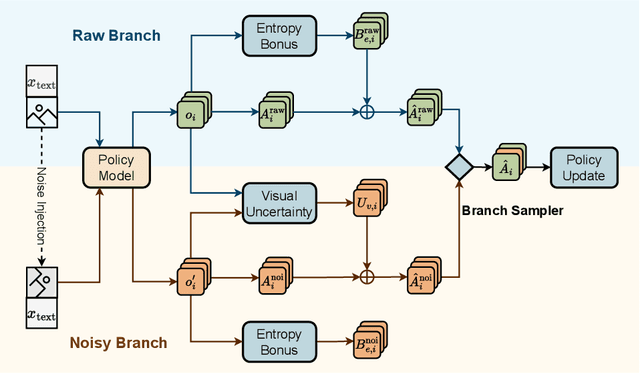
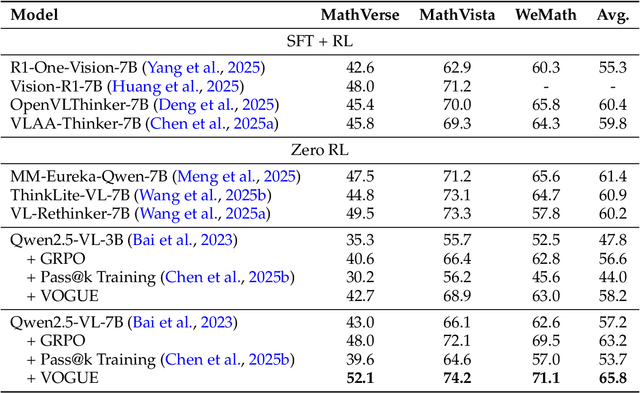
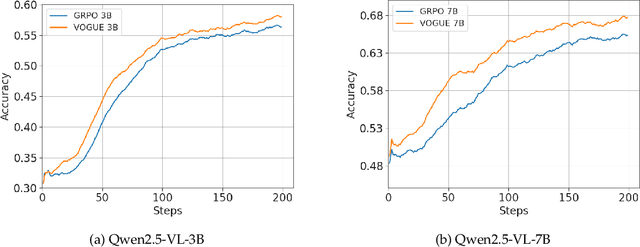
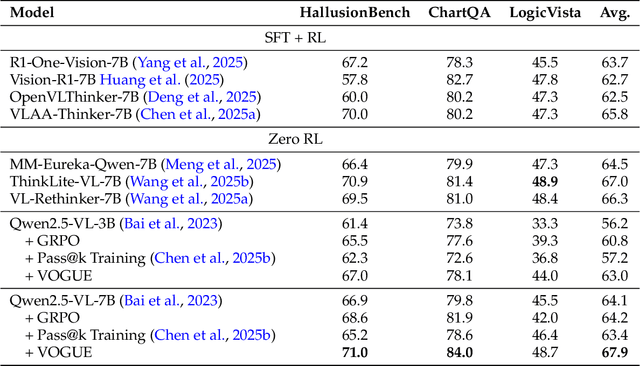
Abstract:Reinforcement learning with verifiable rewards (RLVR) improves reasoning in large language models (LLMs) but struggles with exploration, an issue that still persists for multimodal LLMs (MLLMs). Current methods treat the visual input as a fixed, deterministic condition, overlooking a critical source of ambiguity and struggling to build policies robust to plausible visual variations. We introduce $\textbf{VOGUE (Visual Uncertainty Guided Exploration)}$, a novel method that shifts exploration from the output (text) to the input (visual) space. By treating the image as a stochastic context, VOGUE quantifies the policy's sensitivity to visual perturbations using the symmetric KL divergence between a "raw" and "noisy" branch, creating a direct signal for uncertainty-aware exploration. This signal shapes the learning objective via an uncertainty-proportional bonus, which, combined with a token-entropy bonus and an annealed sampling schedule, effectively balances exploration and exploitation. Implemented within GRPO on two model scales (Qwen2.5-VL-3B/7B), VOGUE boosts pass@1 accuracy by an average of 2.6% on three visual math benchmarks and 3.7% on three general-domain reasoning benchmarks, while simultaneously increasing pass@4 performance and mitigating the exploration decay commonly observed in RL fine-tuning. Our work shows that grounding exploration in the inherent uncertainty of visual inputs is an effective strategy for improving multimodal reasoning.
CDE: Curiosity-Driven Exploration for Efficient Reinforcement Learning in Large Language Models
Sep 11, 2025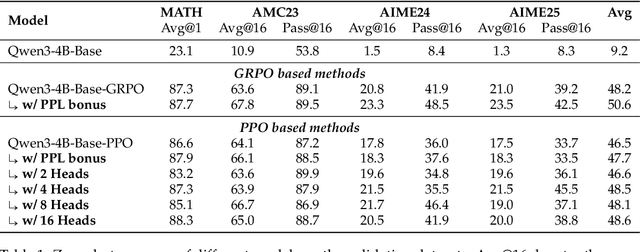

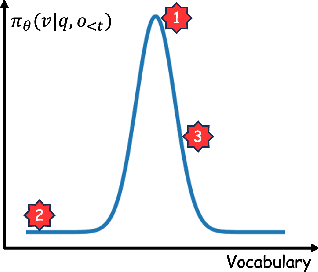

Abstract:Reinforcement Learning with Verifiable Rewards (RLVR) is a powerful paradigm for enhancing the reasoning ability of Large Language Models (LLMs). Yet current RLVR methods often explore poorly, leading to premature convergence and entropy collapse. To address this challenge, we introduce Curiosity-Driven Exploration (CDE), a framework that leverages the model's own intrinsic sense of curiosity to guide exploration. We formalize curiosity with signals from both the actor and the critic: for the actor, we use perplexity over its generated response, and for the critic, we use the variance of value estimates from a multi-head architecture. Both signals serve as an exploration bonus within the RLVR framework to guide the model. Our theoretical analysis shows that the actor-wise bonus inherently penalizes overconfident errors and promotes diversity among correct responses; moreover, we connect the critic-wise bonus to the well-established count-based exploration bonus in RL. Empirically, our method achieves an approximate +3 point improvement over standard RLVR using GRPO/PPO on AIME benchmarks. Further analysis identifies a calibration collapse mechanism within RLVR, shedding light on common LLM failure modes.
Parallel-R1: Towards Parallel Thinking via Reinforcement Learning
Sep 09, 2025Abstract:Parallel thinking has emerged as a novel approach for enhancing the reasoning capabilities of large language models (LLMs) by exploring multiple reasoning paths concurrently. However, activating such capabilities through training remains challenging, as existing methods predominantly rely on supervised fine-tuning (SFT) over synthetic data, which encourages teacher-forced imitation rather than exploration and generalization. Different from them, we propose \textbf{Parallel-R1}, the first reinforcement learning (RL) framework that enables parallel thinking behaviors for complex real-world reasoning tasks. Our framework employs a progressive curriculum that explicitly addresses the cold-start problem in training parallel thinking with RL. We first use SFT on prompt-generated trajectories from easier tasks to instill the parallel thinking ability, then transition to RL to explore and generalize this skill on harder problems. Experiments on various math benchmarks, including MATH, AMC23, and AIME, show that Parallel-R1 successfully instills parallel thinking, leading to 8.4% accuracy improvements over the sequential thinking model trained directly on challenging tasks with RL. Further analysis reveals a clear shift in the model's thinking behavior: at an early stage, it uses parallel thinking as an exploration strategy, while in a later stage, it uses the same capability for multi-perspective verification. Most significantly, we validate parallel thinking as a \textbf{mid-training exploration scaffold}, where this temporary exploratory phase unlocks a higher performance ceiling after RL, yielding a 42.9% improvement over the baseline on AIME25. Our model, data, and code will be open-source at https://github.com/zhengkid/Parallel-R1.
NE-PADD: Leveraging Named Entity Knowledge for Robust Partial Audio Deepfake Detection via Attention Aggregation
Sep 04, 2025Abstract:Different from traditional sentence-level audio deepfake detection (ADD), partial audio deepfake detection (PADD) requires frame-level positioning of the location of fake speech. While some progress has been made in this area, leveraging semantic information from audio, especially named entities, remains an underexplored aspect. To this end, we propose NE-PADD, a novel method for Partial Audio Deepfake Detection (PADD) that leverages named entity knowledge through two parallel branches: Speech Name Entity Recognition (SpeechNER) and PADD. The approach incorporates two attention aggregation mechanisms: Attention Fusion (AF) for combining attention weights and Attention Transfer (AT) for guiding PADD with named entity semantics using an auxiliary loss. Built on the PartialSpoof-NER dataset, experiments show our method outperforms existing baselines, proving the effectiveness of integrating named entity knowledge in PADD. The code is available at https://github.com/AI-S2-Lab/NE-PADD.
Self-Rewarding Vision-Language Model via Reasoning Decomposition
Aug 27, 2025Abstract:Vision-Language Models (VLMs) often suffer from visual hallucinations, saying things that are not actually in the image, and language shortcuts, where they skip the visual part and just rely on text priors. These issues arise because most post-training methods for VLMs rely on simple verifiable answer matching and supervise only final outputs, leaving intermediate visual reasoning without explicit guidance. As a result, VLMs receive sparse visual signals and often learn to prioritize language-based reasoning over visual perception. To mitigate this, some existing methods add visual supervision using human annotations or distilled labels from external large models. However, human annotations are labor-intensive and costly, and because external signals cannot adapt to the evolving policy, they cause distributional shifts that can lead to reward hacking. In this paper, we introduce Vision-SR1, a self-rewarding method that improves visual reasoning without relying on external visual supervisions via reinforcement learning. Vision-SR1 decomposes VLM reasoning into two stages: visual perception and language reasoning. The model is first prompted to produce self-contained visual perceptions that are sufficient to answer the question without referring back the input image. To validate this self-containment, the same VLM model is then re-prompted to perform language reasoning using only the generated perception as input to compute reward. This self-reward is combined with supervision on final outputs, providing a balanced training signal that strengthens both visual perception and language reasoning. Our experiments demonstrate that Vision-SR1 improves visual reasoning, mitigates visual hallucinations, and reduces reliance on language shortcuts across diverse vision-language tasks.
UniTalker: Conversational Speech-Visual Synthesis
Aug 06, 2025Abstract:Conversational Speech Synthesis (CSS) is a key task in the user-agent interaction area, aiming to generate more expressive and empathetic speech for users. However, it is well-known that "listening" and "eye contact" play crucial roles in conveying emotions during real-world interpersonal communication. Existing CSS research is limited to perceiving only text and speech within the dialogue context, which restricts its effectiveness. Moreover, speech-only responses further constrain the interactive experience. To address these limitations, we introduce a Conversational Speech-Visual Synthesis (CSVS) task as an extension of traditional CSS. By leveraging multimodal dialogue context, it provides users with coherent audiovisual responses. To this end, we develop a CSVS system named UniTalker, which is a unified model that seamlessly integrates multimodal perception and multimodal rendering capabilities. Specifically, it leverages a large-scale language model to comprehensively understand multimodal cues in the dialogue context, including speaker, text, speech, and the talking-face animations. After that, it employs multi-task sequence prediction to first infer the target utterance's emotion and then generate empathetic speech and natural talking-face animations. To ensure that the generated speech-visual content remains consistent in terms of emotion, content, and duration, we introduce three key optimizations: 1) Designing a specialized neural landmark codec to tokenize and reconstruct facial expression sequences. 2) Proposing a bimodal speech-visual hard alignment decoding strategy. 3) Applying emotion-guided rendering during the generation stage. Comprehensive objective and subjective experiments demonstrate that our model synthesizes more empathetic speech and provides users with more natural and emotionally consistent talking-face animations.
Scene-aware SAR ship detection guided by unsupervised sea-land segmentation
Jun 15, 2025Abstract:DL based Synthetic Aperture Radar (SAR) ship detection has tremendous advantages in numerous areas. However, it still faces some problems, such as the lack of prior knowledge, which seriously affects detection accuracy. In order to solve this problem, we propose a scene-aware SAR ship detection method based on unsupervised sea-land segmentation. This method follows a classical two-stage framework and is enhanced by two models: the unsupervised land and sea segmentation module (ULSM) and the land attention suppression module (LASM). ULSM and LASM can adaptively guide the network to reduce attention on land according to the type of scenes (inshore scene and offshore scene) and add prior knowledge (sea land segmentation information) to the network, thereby reducing the network's attention to land directly and enhancing offshore detection performance relatively. This increases the accuracy of ship detection and enhances the interpretability of the model. Specifically, in consideration of the lack of land sea segmentation labels in existing deep learning-based SAR ship detection datasets, ULSM uses an unsupervised approach to classify the input data scene into inshore and offshore types and performs sea-land segmentation for inshore scenes. LASM uses the sea-land segmentation information as prior knowledge to reduce the network's attention to land. We conducted our experiments using the publicly available SSDD dataset, which demonstrated the effectiveness of our network.
 Add to Chrome
Add to Chrome Add to Firefox
Add to Firefox Add to Edge
Add to Edge